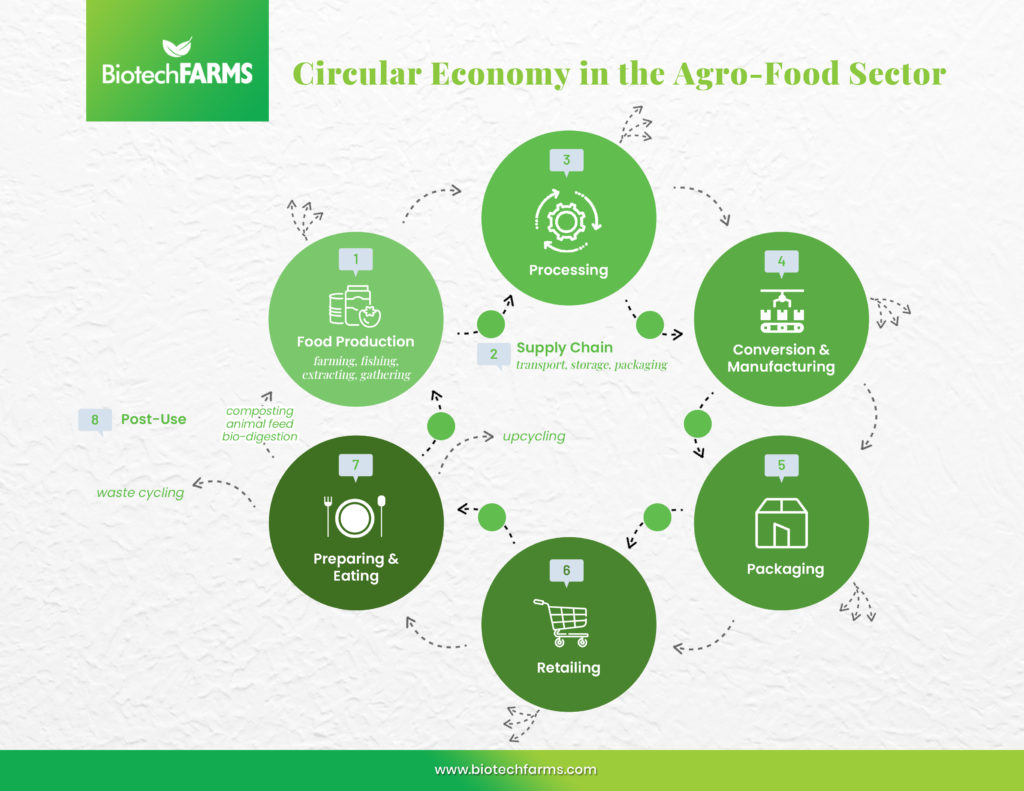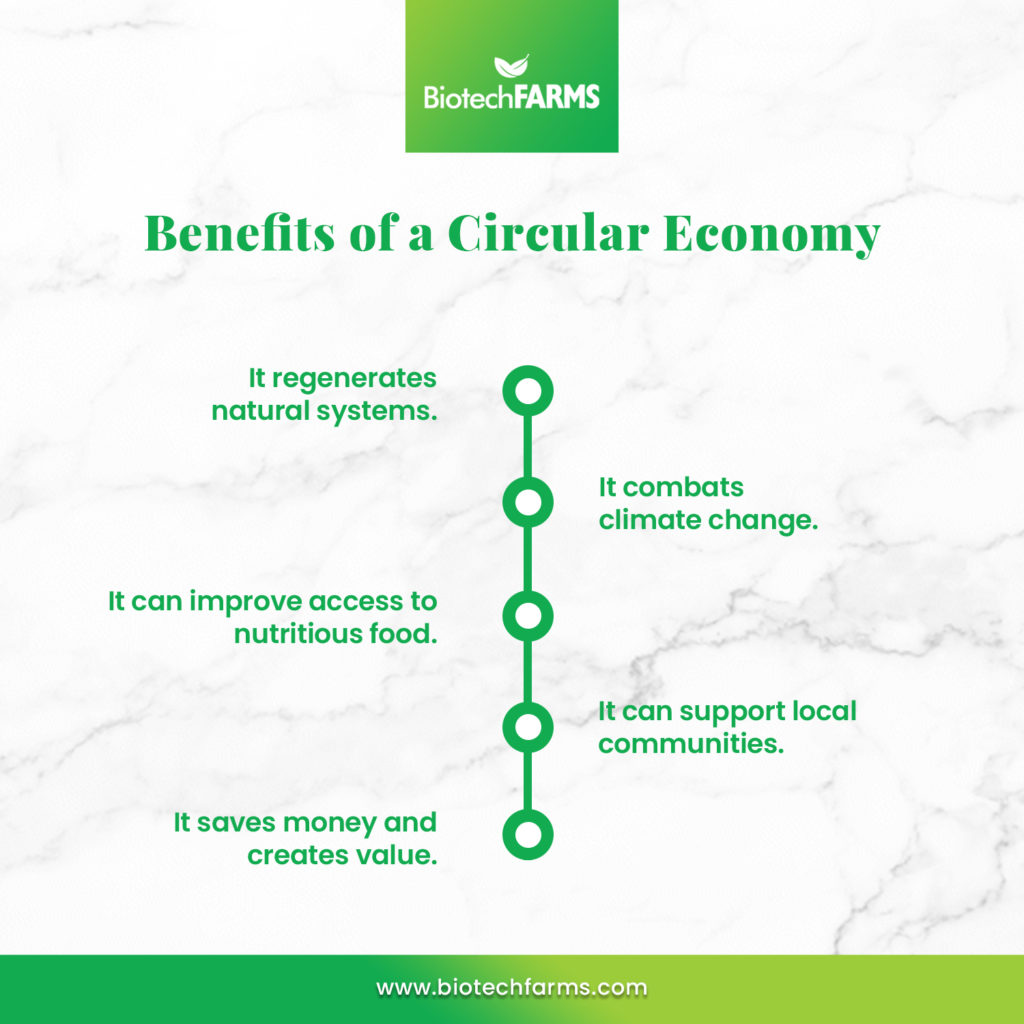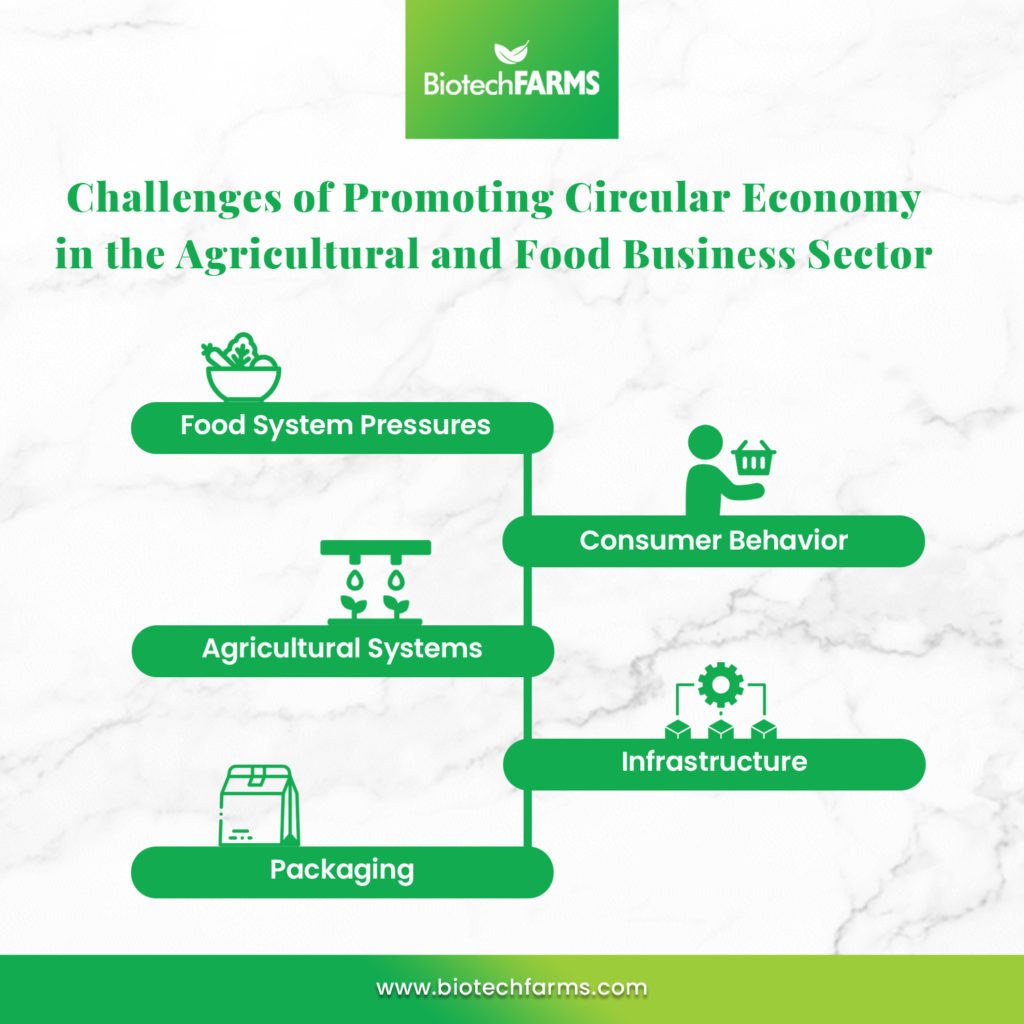Over the past several decades, the current economic model of businesses is based on the take-make-dispose paradigm. Also known as the linear industrial economic model, this model has been widely criticized for its unsustainable practices.
Since the Industrial Revolution, the development of technology has allowed people to better exploit the world’s natural resources and further improve their quality of life. It allowed the world to overcome scarcities in food, shelter, and clothing by using the opportunities of a linear industrial economy. However, the downsides of a linear economy today are overwhelming.
Linear Economy versus Circular Economy
Due to the overexploitation of natural resources, degradation of the environment, the linear industrial economy model is widely known to have adverse effects on the ecosystem.
The agribusiness sector has been particularly affected by resource scarcity, food loss, and waste generation challenges.
The agricultural and food business sector has been paying close attention to issues on food safety, production traceability, and respect for the environment and natural resources. As such, businesses like Biotech Farms have begun to make a move towards more sustainable approaches.
With the publication of the Sustainable Development Goals (SDGs), the protection of natural resources and the protection of human health have also become essential aspects of economic development itself.
As such, the need to radically redesign the traditional linear economy from production and consumption is emerging. This led to the shift towards the circular economy, the most sustainable business model for the agro-food sector.

Circular Economy in the Agro-Food Sector
As a framework developed in response to the linear economic model, the circular economy uses a comprehensive system and thoughtful design to counteract the adverse effects brought by the linear model.
It aims to eliminate waste and pollution, maximize the value of natural resources, and regenerate natural systems. The circular economy of food applies to the agro-food sector.
To properly have a working circular economy model for the agro-food sector, companies like Biotech Farms need to come up with a circular model of food by design. This means that everything in the company needs to be produced and designed to have a positive social and ecological impact for the whole organization.
By making everything a vital part of a natural biological cycle, a circular economy adapts a complex system that aims for eco-effectiveness within the organization.

In agriculture, the circular economy emphasizes the importance of shifting towards a regenerative agricultural model to maximize or eliminate the need for toxic pesticides and synthetic fertilizers.
It also prioritizes soil health and nutrient recycling, including other new technologies and techniques. In some cases, transitioning to this regenerative agriculture model will also involve returning to traditional farming techniques such as composting.
Another primary focus of circular economy advocates is food packaging. While food packaging may extend shelf life and convenience to consumers, its production often generates pollution and unsustainable resource. In addition, some food packaging has become single-use and is ultimately sent to landfills or disposed of in the natural environment.
The circular economy in the agro-food sector also considers how to make food packaging more sustainable to eliminate harmful material by design and incorporate renewable materials and reusable methods.
Benefits of a Circular Economy

It regenerates natural systems.
Food is produced regeneratively in a circular economy. This will improve the overall health of the local ecosystem to protect natural habitats. Regenerative agriculture promotes the production of high-quality food and the improvement of the surrounding ecosystem. Regenerative farmers use organic instead of synthetic fertilizers to boost the productivity of the land in a more sustainable manner.
It combats climate change.
A circular economy could reduce the sector’s greenhouse gas emissions by 49%, or 5.6 billion tonnes of CO2, by 2050. By creating organic fertilizers and turning organic waste into compost, potential gains are beginning to emerge. Businesses aim to reduce greenhouse gas emissions by designing edible food waste by turning what would typically be food by-products like corn cobs into food products.
It can improve access to nutritious food.
A circular economy builds resilience in the food system to improve food security. When global supply chains are disrupted, access to food can be jeopardized. However, organizations that start fostering resilience into their food supply chain will ensure that no matter where or what disruption may occur, local food supply can be accessed by those who need it.
It can support local communities.
A circular economy builds resilience for the local community. By connecting people with the local food production, local farmers can retain their livelihood to benefit both the communities and the environment. Furthermore, by connecting producers with local markets, it creates innovative agro-processing food hubs that advocate the use of local products to enable local farmers to participate in the circular economy in the community.
It saves money and creates value.
By sourcing food grown regeneratively and making the most out of food and waste, the agro-food sector can save money and create more value within the local community. As more and more businesses invest in developing a circular economy, this model will grow to be more popular to help safeguard biodiversity and allow products to be upcycled.
Challenges of Promoting Circular Economy in the Agricultural and Food Business Sector

Food System Pressures
Food production has always made an impact due to various external factors. Among its greatest pressure is resource scarcity. Water, nutrients, soil, and farmlands are all important aspects of the agricultural system, but they are now degraded or limited. Food systems are also being strained by climate change from shifting weather patterns and extreme weather events. These challenges only show how important it is to design a system that eliminates the concept of waste and is resilient to external shock.
Consumer Behavior
Food systems are also highly influenced by our values. A key driver in the pervasive culture of consumption and the perpetual availability of a diversity of products at continually lower prices. At the same time, consumers think very little about the impacts of their production or disposal. Increased public interest in food consumption is shifting consumer demands, but deep-seated cultural values are slow to change.
Agricultural Systems
The predominant agricultural system has evolved to produce a remarkable volume of food at unusually low prices. However, this often occurs at the expense of our depleting natural resources, generating hazardous pollutants, among other environmental and social costs. Advocating a shift towards a circular economy means prioritizing biodiversity, including the protection and preservation of natural resources.
Infrastructure
People often overlook the complex machinery that enables food to move from farm to plate. But these infrastructures require to facilitate them are critical components of the modern food system. Infrastructure is now used to harvest, process, package, transport, track, monitor food from farm to recycling facility and back to the farm again. Circular economy revolutionizes infrastructure to redesign the concept of waste and maintain resilience for maintaining food safety, affordability, and availability.
Packaging
Packaging has become a valuable component of the modern food experience. The problem with packaging is that it is easy to overlook its harmful impacts since it’s often done to extend shelf life and repurpose products for convenient single-use serving sizes. By applying a circular economy approach to packaging, organizations can strive to move away from plastics by pursuing plant-based alternatives to facilitate composting.
Biotech Farms has drastically modernized its agricultural operations with the circular economy at the heart of its business operations.
To meet the ever-growing demands of the international market, Biotech Farms believes that “sustainable products equate to sustainable lives.” We ensure that our number one priority is to provide sustainably sourced food to the Filipino people.
Biotech Farms produces its own renewable energy resource, fertilizers, and irrigation for its farms to provide consumers with safe and high-quality products such as Better Farms, Better Pork, MindaRice, Malaya Rice, and Rice Valley. Get in touch with us to learn more about our products.
References:
Esposito, B., Sessa, M. R., Sica, D., & Malandrino, O. (2020). Towards circular economy in the agri-food sector. A systematic literature review. Sustainability, 12(18), 7401. https://doi.org/10.3390/su12187401
Five benefits of a circular economy for food. (2021). Retrieved 18 July 2021, from https://medium.com/circulatenews/five-benefits-of-a-circular-economy-for-food-21c3654f4393
Stahel, W. R. (2019). The circular economy: A user’s guide.
What is the Circular Economy of Food – GREEN BROWN BLUE. (2021). Retrieved 18 July 2021, from https://www.greenbrownblue.com/what-is-the-circular-economy-of-food/


